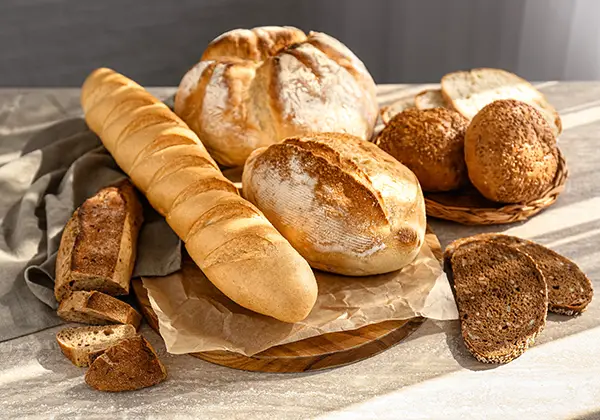Nobody can escape the smell of freshly baked bread, it awakens childhood memories and an appetite for crispy rolls and hearty bread. Unfortunately, only selected bakeries rely on bread ingredients that are free of additives, artificial raising agents, and preservatives.
Only four ingredients are needed to make high-quality bread: flour, water, salt, and time. The clever combination of these four ensures a juicy crumb and crispy crust, more aroma, and longer shelf life.
How to make bread: All you need is flour, water, salt, and time
More and more people are using the knowledge of the old baker’s art, reflecting on the virtue of doing it yourself and baking their own bread. The grandmothers’ recipes are tried out, natural sourdough is prepared, the dough is kneaded by hand and the maturing dough is carefully left alone. The reward for the effort: loosely-pored slices of bread with a fragrant, cracking crust, which are a real pleasure enjoyed straight.
Good, sure-fire recipes are particularly important for beginners in order to develop a feeling for the subject and to be able to achieve initial successes quickly.
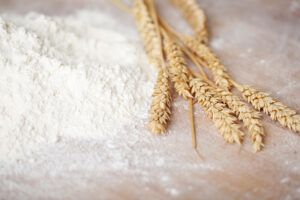
The benefits of homemade bread
Baking your own bread has many advantages. With a long walking time and the use of little yeast or sourdough, bread becomes much more digestible. It also develops a more pronounced, more aromatic taste. Numerous additives, including flavor enhancers, aromas, and preservatives, are used in industrially produced bread. After all, the dough should be easy to process, the taste should always be the same and the shelf life should be as long as possible.
In your own “bakery” you don’t need to worry about it – after all, you know exactly what’s in it. In addition, industrial baked goods are usually transported over many kilometers and may also lie on the shelf for a long time. Thus, the freshness is also an advantage of home-baked bread.
Which flour do I need to make bread?
We owe our bread diversity to the different types of flour and their mix. Wheat, rye, and spelt flour are mainly used to bake bread. They are available with different types of designations. The type designation indicates the ash content of the flour in milligrams per 100 g. It is determined by burning 100 g of flour and weighing the remaining ash. The corresponding measured value then becomes the type number.
The weight of the ashes is almost identical to the mineral content of flour. Therefore, the type of flour is often referred to as mineral content. Minerals, fiber, and vitamins are mainly located in the outer layers of the grain. The more the grain is ground, i.e. the more shell is used in the finished flour, the higher the mineral content.
[maxbutton name=”Do you like this article”]
Darker flour has a higher degree of grinding, higher mineral content, and therefore a higher type designation. Lighter flour was ground accordingly less strongly, has a lower mineral content, and has a lower type designation. Whole grain flour does not have a type designation, as the whole grain is ground here and all of its mineral content is retained. It is the same with other types of flour in which the entire grain or the entire fruit is ground (e.g. buckwheat flour).
The different types of flour sometimes have very different baking properties. In principle, every flour can be used for every baked good, but you will achieve the best results with the appropriate types. In general, it can be said that light flours, i.e. flours with a low number of types, are particularly suitable for fine baked goods such as cakes and rolls, while darker flours are more suitable for hearty baked goods such as rustic bread.
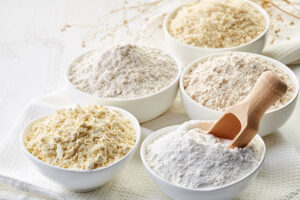
Rye or wheat bread?
Wheat is the most important grain for bread worldwide. Whether breakfast rolls, baguette, ciabatta, or brioche – all these light bread are made from them. Wheat is particularly rich in gluten, which makes the dough stretchy and elastic. The glue can bind a lot of water and thus ensures an airy and loose structure of the baked goods. A little yeast is sufficient for wheat flour as a raising agent. It is especially ideal for beginners: the gluten makes the dough stick together more easily and it does not react sensitively to long kneading. The addition of wheat flour to bread dough made from other types of flour ensures that the bread rises better.
In contrast to wheat bread, rye bread is characterized by a darker dough and a thicker crumb. Rye doesn’t contain as much gluten, which makes the dough heavier and denser. Rye flour needs an acidic environment in order to be bakeable. An age-old method is adding sourdough.
Sourdough is used for loosening, souring, and flavoring doughs made from rye flour. Natural sourdough contains lactic acid bacteria and yeasts. These form just 24 hours after preparing and give the dough a pleasantly sour note.
Yeast: how to use when making bread
Dissolve the fresh yeast in lukewarm liquid, then knead in the remaining ingredients. A pinch of sugar feeds the yeast and thus starts the desired fermentation process. Under no circumstances should salt be added in this first step. Salt attacks the yeast cells and causes them to die.
The right ratio of flour to yeast is important for a light, airy dough for both fresh and dry yeast. For a pound of wholemeal wheat flour, you calculate with 15 grams of fresh yeast, with pure white wheat flour 10 grams of yeast is enough.
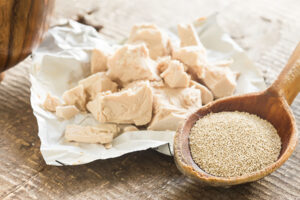
Using sourdough when making bread
Sourdough is a leavening agent that has been added to dough to loosen it for thousands of years. With the help of a starter culture, you can easily make it yourself. Lactic acid bacteria and yeasts keep sourdough fermenting permanently. The resulting carbon dioxide loosens the dough.
Breads of all kinds are made more digestible by adding sourdough. Wheat sourdough consists of wheat flour, water, yeast and lactic acid bacteria. It is used, for example, for baguette, ciabatta or other light breads. Rye sourdough is also composed, only with rye instead of wheat flour. It is mainly used in rye and mixed rye breads.
The Italian Lievito Madre is a special form of sourdough. In addition to flour and water, it also contains a little honey and olive oil, which gives it a special aroma. Lievito Madre gives light breads, rolls, pizza and sweet doughs a wonderful taste.
Fat in making bread
Butter or high-quality oils refine the bread dough. It is important that you knead the remaining ingredients and only then add the fat.
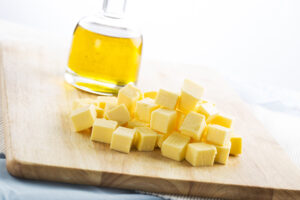
Salt in bread making
Salt stabilizes the consistency of the dough. It does not become firmer, but its taste is more stable. As paradoxical as it sounds: Especially sweet doughs need a small pinch of salt, as a flavor carrier it underlines the sweetness in the dough.
The reverse is also true: the taste of something salty is improved with a pinch of sugar or honey.

A simple recipe to make bread
INGREDIENTS FOR 1 BREAD LOAF:
- 400 g semi-white flour
- 9 g salt
- 1 teaspoon honey
- 10 g fresh yeast
- 280 ml water
HOW TO MAKE BREAD:
- Knead all ingredients in a food processor to form a delicate dough. If necessary, add a little more flour or water. The dough shouldn’t be too firm. Kneading should take about 10 minutes.
- Put flour on the work surface and form a ball out of the dough and place on the floured work surface. Dust with flour, cover with a kitchen towel and let rest for about 30 minutes.
- Then fold the dough, make it round and let it rest under the kitchen towel for another 30 minutes.
- After this resting time, tighten the dough again by making it look round and let it rest for another 15 minutes.
- During this time, preheat the oven to 230 C degrees (both top/bottom heat). And if you have two baking trays, put them in the oven, one of them at the bottom. You will need that to generate steam.
- Cut the bread crosswise with a sharp knife or a razor blade, take the top hot baking sheet out of the oven for a moment, place the bread on top and push it into the oven.
- Pour a cup of water on the lower tray in the oven and close the oven immediately.
- Bake for 15 minutes at 230 degrees, then open the oven briefly to let the remaining steam escape and bake for about 15 minutes at 230 degrees. Take it out of the oven and listen to the crackling of the bread!
[maxbutton name=”Do you like this article”]
Should you use bread mixes to make bread?
The use of high-quality bread mixes is ideal for hobby bakers who want to achieve convincing results quickly. This is particularly quick and easy in a bread maker. However, you should be careful when choosing the mix: up to 200 ingredients are allowed in industrially produced baking mixes. If you want to avoid these substances, it is best to rely on mixtures of natural ingredients – preferably in organic quality.
Consistency of bread: why is it important in making bread
For rolls and bread, water is added to the dough. It ensures that they get nice and crispy. Doughs for yeast plaits or brioche, whose consistency is rather soft, are made with milk. Basically, the dough should be soft and sticky at first, too much flour in the dough makes the bread dry.
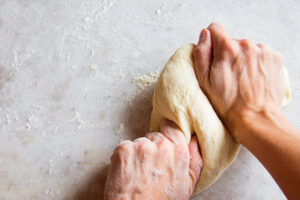
How to knead bread
Yeast dough is actually happy about rough handling, persistent kneading, and whipping. This creates the protein framework, which later ensures a loose and at the same time a stable loaf of bread during baking. It is important to knead the dough vigorously again after the first proofing process. The fermentation gases and newly formed yeasts are optimally distributed in the dough.
Spelled dough and rye dough with sourdough, on the other hand, must not be kneaded for too long: Just one minute too much and you will later take a flatbread out of the oven.
How to make bread: Warmth also matters
The yeast itself prefers cozy warmth around 30 ° C and multiplies under these conditions to the baker’s delight: the dough rises and increases its volume enormously in a relatively short time. Sourdough feels most comfortable at temperatures between 28-30 ° C and develops a stronger taste.
An automatic proofer, which can be set to the exact degree, ensures the constant temperature of the dough, thus ensuring perfect conditions. There are also dough recipes that require dough to rise at cool temperatures. Here the rest time is a lot longer. The baked bread is a lot finer-pored after a so-called cold cooking.

Shape of the bread: Use creativity
Proofing baskets are usually made of wicker and ensure that the bread gets its typical shape and a beautiful pattern before baking. After the dough has risen in the proofing basket, it can be turned onto a baking plate or baking sheet and then baked. With bread that are baked in a conventional loaf pan, only the top of the bread becomes crispy. They are therefore better suited for soft loaves of bread.
How to make bread: a trick to make a crispy crust
If you want your bread to be particularly crispy, you need to ensure that there is sufficient moisture in the oven. For this you can simply put a bowl of water in the oven. The evaporating water condenses on the surface of your bread dough and prevents a crust from forming too quickly. After all, you want your bread to rise even further in the oven.
If the crust formed too quickly, however, the fermentation gases would not be able to escape – the bread would remain small and compact. In addition, the crust of steamed bread turns out to be significantly crisp.

How to make bread: baking is crucial
Bread should always be baked in a preheated oven. You achieve the best results with top/bottom heat, as circulating air dries out the bread too quickly. Start with a high temperature (220-250 ° C), which you then reduce after a short baking time (to approx. 200 ° C). This way the bread builds up a good volume. High temperatures, coming from above and below at the same time, ensure that the moisture is optimally retained in the bread.
High-quality baking plates and molds with ideal heat distribution also ensure a uniform result. Those who like it particularly quick and easy can prepare their bread in a high-quality bread maker. In it, you can not only bake but also mix the ingredients and knead the dough.
Store home-baked bread correctly
Only those who store their home-baked bread properly can enjoy it for several days. The “death knell” for any bread is keeping it in a plastic bag or can. Moisture that escapes from the bread cannot be released to the outside and forms a breeding ground for mold.
High-quality bread boxes made of natural materials such as earthenware, clay, or wood are best suited for storing bread. They are breathable and allow air to circulate. However, since the crumbs from the previous bread are a gateway for mold spores, bread boxes should be cleaned regularly with vinegar.
[maxbutton name=”Do you like this article”]
Homemade bread can be kept for up to a week. Important: Before you can put it in the bread box, the home-baked bread should absolutely cool down completely, otherwise moisture will form.
Under no circumstances should bread be stored in the refrigerator. The cold dries it up and it tastes stale. To make it last longer, freezing is the better solution. Packaged airtight, bread can be frozen whole or sliced in portions. It then keeps its aroma for about 6 or 3 months.

FAQ
Which types of grain can I use to make bread?
Regardless of whether you use wheat, spelled, rye, emmer, einkorn, barley, corn, millet or rice to bake bread – botanically speaking, these are seeds from the plant family of sweet grasses. Pseudo-cereals (e.g. amaranth, buckwheat or quinoa) are grains that can also be used to make bread, but belong to a different species.
What is suitable as a bread spice?
Caraway seeds, fennel, anise and coriander are the classic bread spices. The essential oils contained in them originally had the task of making baked goods more digestible, the taste was secondary. Bread and spices are closely linked in the history of medicine. So-called “gastric breads” were once baked by nuns according to traditional recipes and given as medicine.
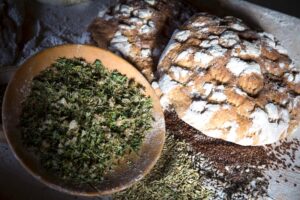
How quickly should I knead the bread?
Two processing steps are important for the development of the bread dough: When mixing slowly, the ingredients mix first and swell. The somewhat faster kneading – bakers put the machines on the next higher level – takes place afterwards and works tension in the dough. Both can be done either by hand or using powerful kitchen machines.
How to make crusty bread?
What tastes best about bread? The crispy rind! To have this taste in the crumb, you can add toasted bread to the dough. It’s a traditional baker’s method. To do this, stale pieces of bread are roasted in the oven, mixed with water, mixed up and added to the dough. At the same time, this is a great way to use leftover bread.
[maxbutton name=”Do you like this article”]

